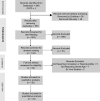CBCT in dental age estimation: A systematic review and meta analysis
- PMID: 34995103
- PMCID: PMC9499196
- DOI: 10.1259/dmfr.20210335
CBCT in dental age estimation: A systematic review and meta analysis
Abstract
Objectives: This study aimed to investigate the reproducibility of dental age estimation methods in cone beam computed tomography (CBCT) and the correlation between dental (DA) and chronological (CA) ages.
Methods: The scientific literature was searched in six databases (PubMed, Scopus, LILACS, Web of Science, SciELO, and OATD). Only observational studies were selected. Within each study, the outcomes of interest were (I) the quantified reproducibility of the method (κ statistics and Intraclass correlation coefficient); and (II) the correlation (r) between the dental and chronological ages. A random-effect three-level meta-analysis was conducted alongside moderator analysis based on methods, arch (maxillary/mandibular), population, and number of roots.
Results: From 671 studies, 39 fulfilled the inclusion criteria, with one study reporting two different methods. The methods used in the studies were divided into metric (n = 17), volumetric (n = 20), staging (n = 2), and atlas (n = 1). All studies reported high examiner reproducibility. Group 1 (metric and volumetric) provided a high inverse weighted r ([Formula: see text] = -0.71, CI [-0.79,-0.61]), and Group 2 (staging) provided a medium-weighted r ([Formula: see text] = 0.49, CI [0.44, 0.53]). Moderator analysis on Group one did not show statistically significant differences between methods, tooth position, arch, and number of roots. An exception was detected in the analysis based on population (Southeast Asia, [Formula: see text] = -0.89, CI [-0.94,-0.81]).
Conclusion: There is high evidence that CBCT methods are reproducible and reliable in dental age estimation. Quantitative metric and volumetric analysis demonstrated better performance in predicting chronological age than staging. Future studies exploring population-specific variability for age estimation with metric and volumetric CBCT analysis may prove beneficial.
Keywords: Age Determination by Teeth; Cone Beam Computed Tomography; Forensic dentistry; radiology; systematic review.
Figures
Similar articles
-
3D segmentation of dental crown for volumetric age estimation with CBCT imaging.Int J Legal Med. 2023 Jan;137(1):123-130. doi: 10.1007/s00414-022-02898-8. Epub 2022 Oct 5. Int J Legal Med. 2023. PMID: 36197526 Free PMC article.
-
Dental age estimation using cone-beam computed tomography: A systematic review and meta-analysis.Imaging Sci Dent. 2023 Jun;53(2):91-99. doi: 10.5624/isd.20221226. Epub 2023 Feb 11. Imaging Sci Dent. 2023. PMID: 37405204 Free PMC article. Review.
-
Age estimation by pulp/tooth area ratio in anterior teeth using cone-beam computed tomography: comparison of four teeth.J Appl Oral Sci. 2019 Aug 12;27:e20180722. doi: 10.1590/1678-7757-2018-0722. J Appl Oral Sci. 2019. PMID: 31411266 Free PMC article.
-
A new age estimation procedure based on the 3D CBCT study of the pulp cavity and hard tissues of the teeth for forensic purposes: A pilot study.J Forensic Leg Med. 2015 Nov;36:150-7. doi: 10.1016/j.jflm.2015.09.015. Epub 2015 Sep 30. J Forensic Leg Med. 2015. PMID: 26458182
-
Pulp volume quantification methods in cone-beam computed tomography for age estimation: A critical review and meta-analysis.J Forensic Sci. 2023 May;68(3):743-756. doi: 10.1111/1556-4029.15248. Epub 2023 Mar 31. J Forensic Sci. 2023. PMID: 36999688 Review.
Cited by
-
Demirjian's and Cameriere's Methods for the Assessment of Dental Age Estimation in Children from a Southern Brazilian City.Diagnostics (Basel). 2024 Jul 13;14(14):1513. doi: 10.3390/diagnostics14141513. Diagnostics (Basel). 2024. PMID: 39061650 Free PMC article.
-
Age estimation by volumetric analysis of teeth using cone beam computed tomography.Oral Radiol. 2024 Jul;40(3):436-444. doi: 10.1007/s11282-024-00750-w. Epub 2024 Apr 8. Oral Radiol. 2024. PMID: 38589600
-
Age Estimation in Brazilian Adults Using the Pulp/Tooth Ratio of the Maxillary Canine and Mandibular Second Premolar.Diagnostics (Basel). 2024 Mar 31;14(7):749. doi: 10.3390/diagnostics14070749. Diagnostics (Basel). 2024. PMID: 38611662 Free PMC article.
-
Early diagnosis of acute lymphoblastic leukemia utilizing clinical, radiographic, and dental age indicators.Sci Rep. 2025 Apr 11;15(1):12376. doi: 10.1038/s41598-025-95014-w. Sci Rep. 2025. PMID: 40210878 Free PMC article.
-
Which method can be used to assess chronologic age in children?BMC Oral Health. 2025 Jun 3;25(1):886. doi: 10.1186/s12903-025-06232-7. BMC Oral Health. 2025. PMID: 40462079 Free PMC article.
References
-
- Willems G. A review of the most commonly used dental age estimation techniques. J Forensic Odontostomatol 2001; 19: 9–17. - PubMed
-
- Pinchi V, Pradella F, Buti J, Baldinotti C, Focardi M, Norelli GA. A new age estimation procedure based on the 3d cbct study of the pulp cavity and hard tissues of the teeth for forensic purposes: a pilot study. J Forensic Leg Med 2015; 36: 150–57: S1752-928X(15)00182-1. doi: 10.1016/j.jflm.2015.09.015 - DOI - PubMed


